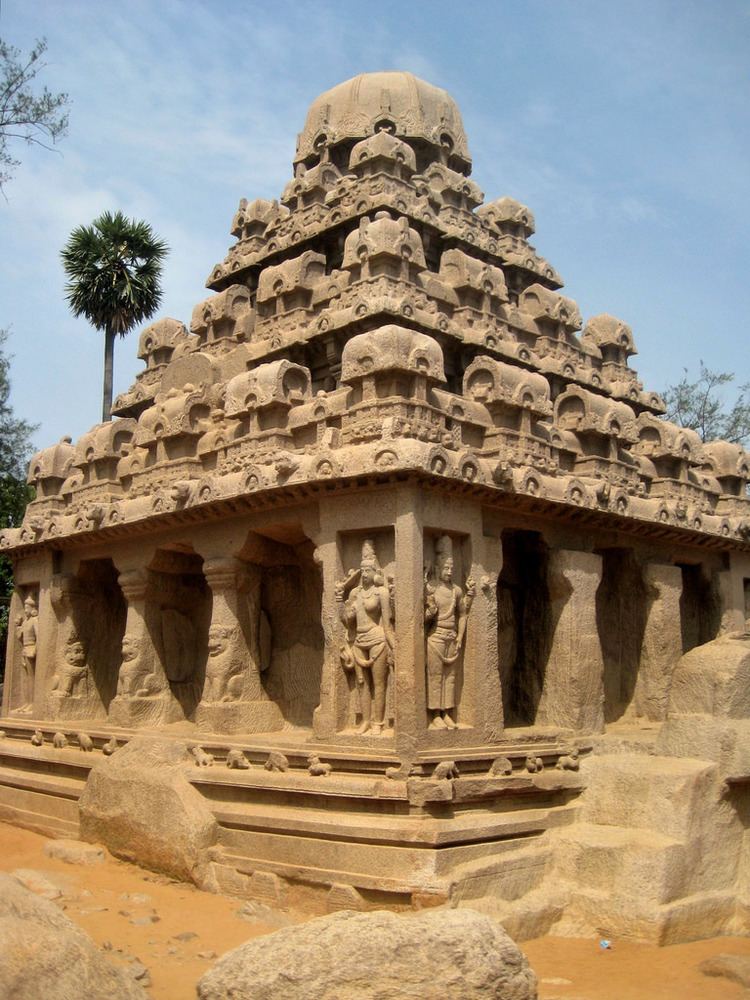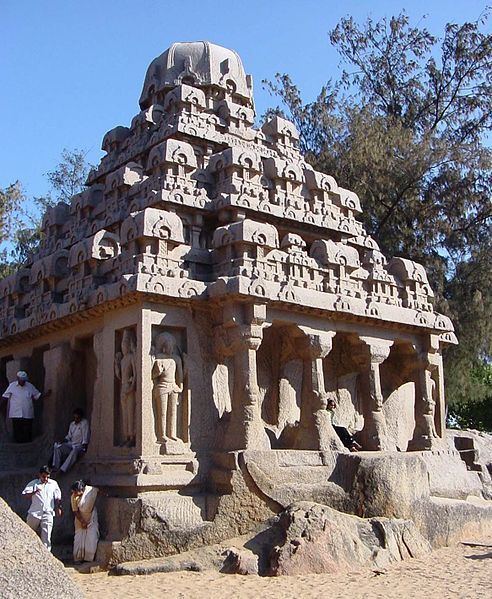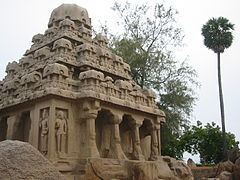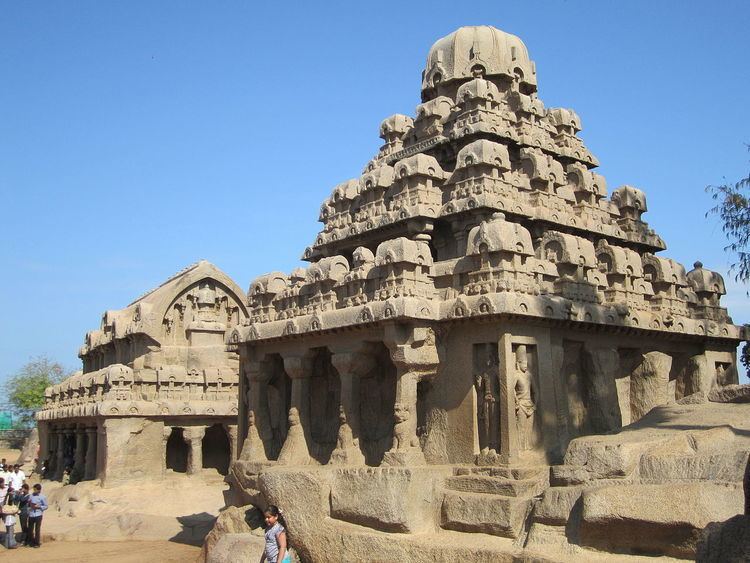Location Mahabalipuram District Kanchipuram district | Date built c. 650 Common era | |
 | ||
Similar Draupadi Ratha, Bhima Ratha, Arjuna Ratha, Nakula Sahadeva Ratha, Pancha Rathas | ||
Dharmaraja ratha five rathas complex mahabalipuram india
Dharmaraja Ratha is a monument in the Pancha Rathas complex at Mahabalipuram, on the Coromandel Coast of the Bay of Bengal, in the Kancheepuram district of the state of Tamil Nadu, India. It is an example of monolith Indian rock-cut architecture. Dating from the late 7th century, it is attributed to the reign of King Mahendravarman I and his son Narasimhavarman I (630–680 AD; also called Mamalla, or "great warrior") of the Pallava Kingdom. The entire complex is under the auspices of the Archaeological Survey of India (ASI). It is one of the Group of Monuments at Mahabalipuram that were designated as a UNESCO World Heritage Site since 1984.
Contents
- Dharmaraja ratha five rathas complex mahabalipuram india
- Dharmaraja ratha
- Geography
- History
- Architecture
- Features
- Inscriptions
- References

Resembling a chariot (ratha), it is carved out of a single, long stone of pink granite. Though sometimes mistakenly referred to as a temple, the structure was not consecrated because it was not completed following the death of Narasimhavarman I. The structure is named after the eldest of the Pancha Pandavas, of epic Mahabharata fame, though the nomenclature is not supported by history. It is dedicated to Shiva.

Dharmaraja ratha
Geography

The structure is located at Mahabalipuram (previously known as Mammallapuram) on the Coromandel Coast of the Bay of Bengal in Kancheepuram district. It is approximately 35 miles (56 km) south of Chennai (previously known as Madras), the capital city, while Chengalpattu is about 20 miles (32 km) away.
History

The five rathas have been important for the development of Indian temple architecture. Like the other four Pancha Rathas, Dharmaraja is built from stone, a replica of a wooden version which preceded it. Though it is considered to be a monolith temple, "temple" is a misnomer given that the five rathas were never completed, as evidenced by uncarved bedrock at the pinnacle. Hence, the rathas were neither consecrated nor was worship offered. The incomplete status of all the five rathas is attributed to the death of the king Narasimhavarman I in 668 AD. Even the epic name associated with the Pandavas is not supported by history. Along with several other monuments, this ratha gained UNESCO World Heritage Site distinction in 1984 as "Group of Monuments at Mahabalipuram".

Considering the large size and depictions of this ratha, its construction could be assigned to two rules of the Pallava Dynasty, one was Narasimhavarman I Mamalla and his successor king Parameshvaravarman I (whose inscription is found in the ratha. Its name as Dharmaraja Ratha is also justified as it is largest of the all the rathas and Dharmaraja was the eldest of the Pandava brothers. This ratha is similar in design to Arjuna Ratha but bigger in size, with an additional floor.
Architecture
All the Pancha Rathas are aligned in a north-south direction and share a common plinth. They have no precedent in Indian architecture and have proved to be "templates" for building larger temples in the South Indian tradition of Dravidian temple architecture. Though cut out of monolithic rocks, they are carved in the form of structural temples in regular building form and hence termed as “quasimonolithic temple form.
Dharmaraja Ratha is the most prominent architecturally of the five rathas and also the tallest and largest. The ratha faces west and is sculpturally very rich. It has three floors including the ground floor. The plan of the ground floor measure a square of 28 feet (8.5 m) and has a height of 35 feet (11 m) from ground level to the top of the roof. It is open on all four sides and the facade on all sides are supported by two pillars and two pilasters with the corners forming an integral part of the support system for the upper floors. Carved out from a single rock of pink granite, along with other three rathas on a single block of stone oriented in a north-south direction, it is a trithala or three-story vimana, square in plan, with open porches and a terraced pyramidal tower. and an octagonal shikhara (pinnacle) at the top. Small-sized model shrines called kudus make up the ornament of the upper part of the tower. There are many sculptures on the corners of the sanctum, which depict Shiva; Harihara, Brahma-Sasta, Skanda, Brahma, Ardhanarisvara (half Shiva half Parvati) and Krishna are depicted alongside an inscribed portrait of a king, indicated to be Narasimhavarman I, who commissioned the temple. The shafts of the pillars are supported by seated lions. The second floor contains rich imagery, with further depictions of Shiva as Gangadara and Natesa, and Vishnu resting on Garuda and Kaliya Mardhana.
Features
Iconographically, the stone carvings in this ratha are seen for the first time, both in Pallava and South Indian history. Its three floors are studded with carved icons. In the ground floor, there are eight niches on the external faces which also have inscriptions of the kings who built the ratha; the west wall has two Shiva icons (with four arms in sambhaga posture), the adjoining niche also is of Shiva with four arms but with jatamukuta (hair gathered above the head); the north face also has two niches with one niche of the Brahma icon with four arms and ornamented and the other niche has an icon of Harihara (combination of Hari (Vishnu) and Hara (Shiva), with four arms; in the two niches on the eastern face one has Ardhnarishvara (half male (Shiva) and half female (Shakti)) and Skanda as Brahmasasta, in the next niche; in the southern face two niches are of Shiva standing in sambhaga posture (with the titles inscribed on the top of the niches as "Srimegha (the cloud of wealth) and ‘Trailokyavardhana, the bestower of prosperity on three worlds") and another icon of Pallava king Narasimhavarman I Mamalla. The cornice of the ground floor runs on all the sides with usual motif of kudus (Horse-shoe shaped dormer windows) and a human face inside. Below the cornice on the west face is a horizontal frieze of ganas holding garlands which is the main entrance to the ratha. The cornice also has usual carvings of oblong shrines interlinked with covered cloisters, and Kudus are a common feature on the shrines and the cloister.
In the first floor of the ratha (which can be seen by climbing up a ladder as there is no built in stairway) twenty niches are decorated with images of Kankalamurti, Vinadhara, dancing Shiva, Shiva with Candesha, Gangadhara, Vishnu, Kalari, Vrsabhantikamurti, Andhakasurasamhamurti, Krishna with figurines of women with offerings, dvarpalas (doorkeepers) and priests of the temple.
In the second storey, which is in a fully completed form cells are provided on both sides of the hall with niches. The entrances to the cells are flanked by dvarpalas. In one cell, the earliest depiction of Somaskanda panel is carved in which Parvati is seated facing Shiva unlike other similar panels elsewhere in other shrines. Though a mortise hole and an outlet to drain out water, indicative of worship offered here in the past, is recorded, the Shiva Linga in now missing. The north face on this floor has a cell with five niches. One niche has icon of Chandra (Moon) in the middle flanked by devotees. The east face also has five niches; its main icon is Surya (Sun) at the centre flanked by two devotees. The southern face also has five niches; with Shiva in the centre flanked two devotees.
Inscriptions
On the Dharmaraja Rathas there are 16 inscriptions in Grantha and Nagari scripts in Sanskrit inscriptions on which are royal cognomen, single-word titles, most of them are attributed to Narasimhavarman I. On the top tier of the temple is an inscription which refers to it as Atyantakama Pallavesvaram; Atyantakama was one of the known titles of Paramesvaravarman I. Other inscribed titles for the king are Shri Megha and Trailokiya–vardhana-vidhi.
